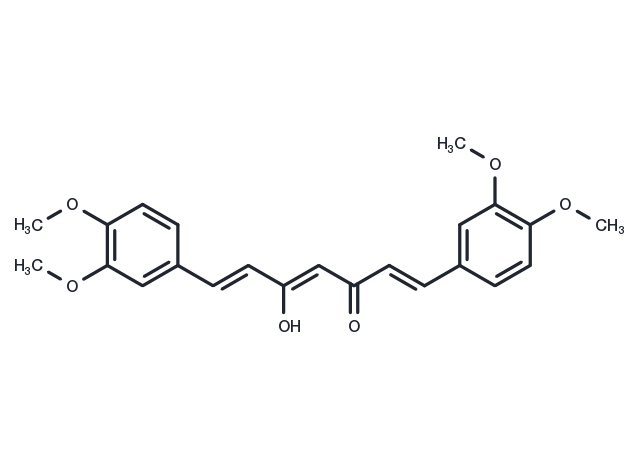Powder: -20°C for 3 years | In solvent: -80°C for 1 year


Dimethylcurcumin (ASC-J9) (ASC-J9) is an androgen receptor degradation enhancer. It effectively suppresses castration-resistant prostate cancer cell proliferation and invasion.

| Pack Size | Availability | Price/USD | Quantity |
|---|---|---|---|
| 20 mg | In stock | $ 130.00 | |
| 1 mL * 10 mM (in DMSO) | In stock | $ 54.00 |



| Description | Dimethylcurcumin (ASC-J9) (ASC-J9) is an androgen receptor degradation enhancer. It effectively suppresses castration-resistant prostate cancer cell proliferation and invasion. |
| In vitro | Dimethylcurcumin is able to degrade fAR and AR3 in a dose-dependent manner in various human PCa cells. Dimethylcurcumin can also effectively suppress AR-targeted genes in CWR22Rv1-fARKD cells. Dimethylcurcumin (5 or 10 μM) significantly suppresses the DHT-induced cell growth in all three PCa cell lines. Dimethylcurcumin suppresses AR-targeted genes and cell growth by the degradation of fAR and ectopic AR3 in C81 and C4-2 cells [1]. ASC-J9 reduces the AR aggregated AR-112Q in cells. Dimethylcurcumin suppresses the aggregation of AR-112Q in SBMA PC12/AR-112Q cells [2]. |
| In vivo | Dimethylcurcumin (75 mg/kg, i.p.) degrades both fAR and AR3 in the xenografted tumors in vivo and ASC-J9-treated tumors have significantly decreased Ki67-positive cells [1]. Dimethylcurcumin (50 mg/kg every 48 h, i.p.) substantially ameliorates the SBMA symptoms in AR-97Q mice and ameliorates neuromuscular pathological findings [2]. ASC-J9-treated mice show significantly smaller prostate tumor sizes when compared with those receiving classic ADT/castration with little serum androgen [3]. |
| Cell Research | For the cell survival assay, the PC12/AR-112Q and PC12/AR-10Q cells are cultured as described previously and incubated cells in the presence of 10 μg/mL doxycycline for 24 h. Then the cells are treated with a vehicle, 5 μM Dimethylcurcumin or 10 μM Dimethylcurcumin, along with 1 nM DHT, and determined cell viability using Trypan blue staining at specific time intervals [2]. |
| Animal Research | CWR22Rv1 cells (1×10^6 cells per site) are injected into both anterior prostates of the castrated nude mice after 2 weeks of implantation. The mice were randomly divided into two groups (four mice/eight tumors each group) and either receive 75 mg/kg Dimethylcurcumin intraperitoneal injection or vehicle control every other day. After 4 weeks of treatment, all mice are killed to examine the tumor growth. Body weights and mice activity are measured weekly [1]. |
| Source |
| Synonyms | ASC-J9, GO-Y025 |
| Molecular Weight | 396.43 |
| Formula | C23H24O6 |
| CAS No. | 52328-98-0 |
Powder: -20°C for 3 years | In solvent: -80°C for 1 year
DMSO: 48 mg/mL (121.08 mM)
H2O: Insoluble
You can also refer to dose conversion for different animals. More
bottom
Please see Inhibitor Handling Instructions for more frequently ask questions. Topics include: how to prepare stock solutions, how to store products, and cautions on cell-based assays & animal experiments, etc.
Dimethylcurcumin 52328-98-0 Endocrinology/Hormones Androgen Receptor inhibit ASC-J9 GO-Y 025 Inhibitor GO-Y025 GO-Y-025 inhibitor
